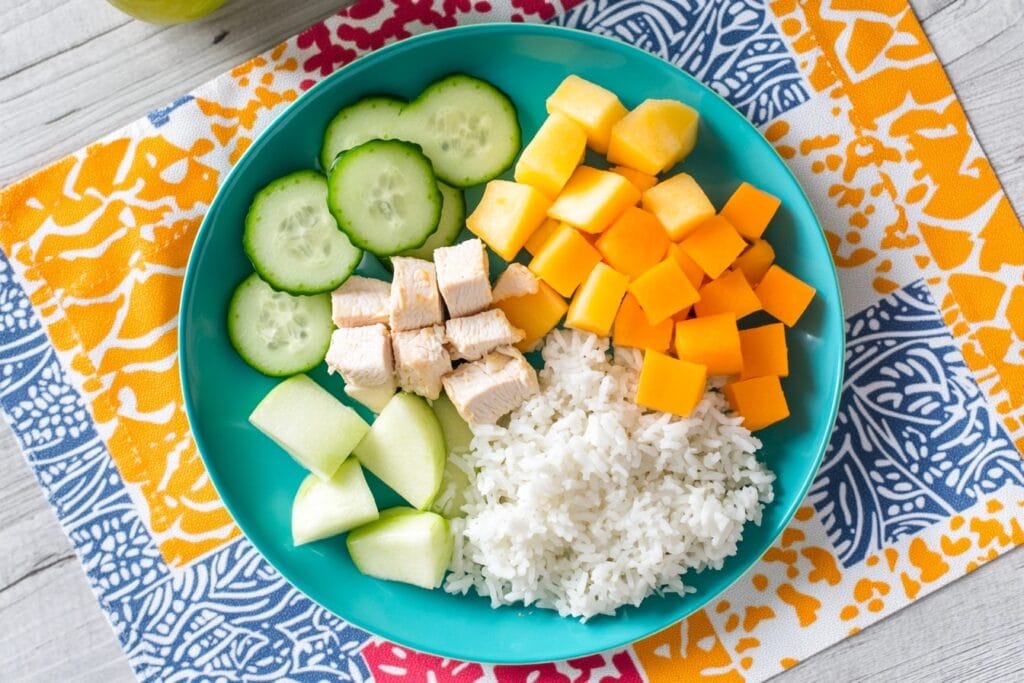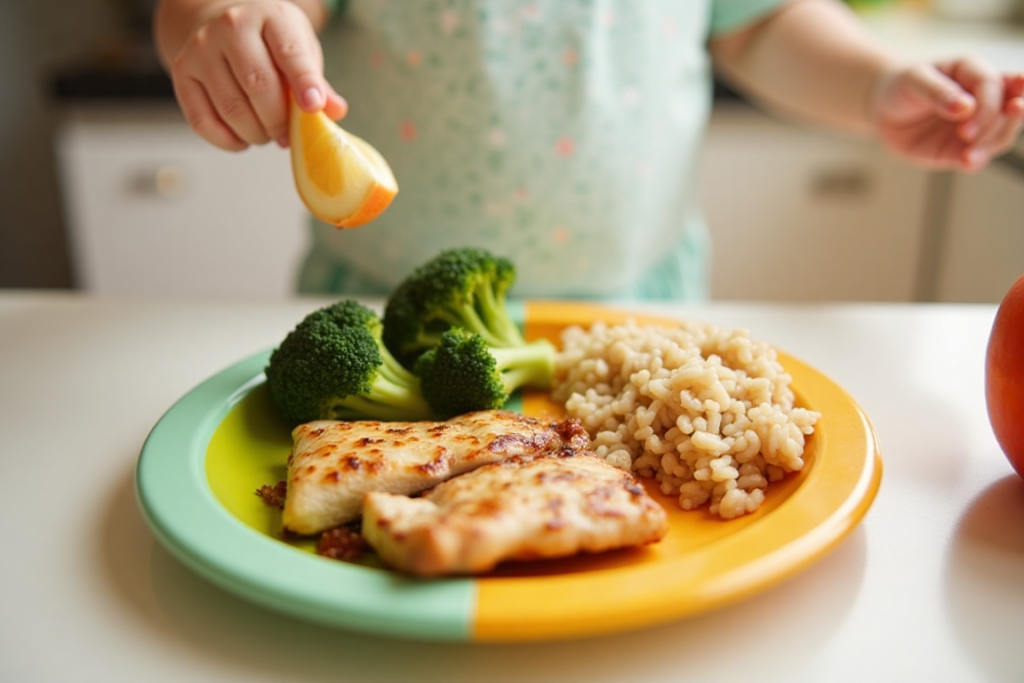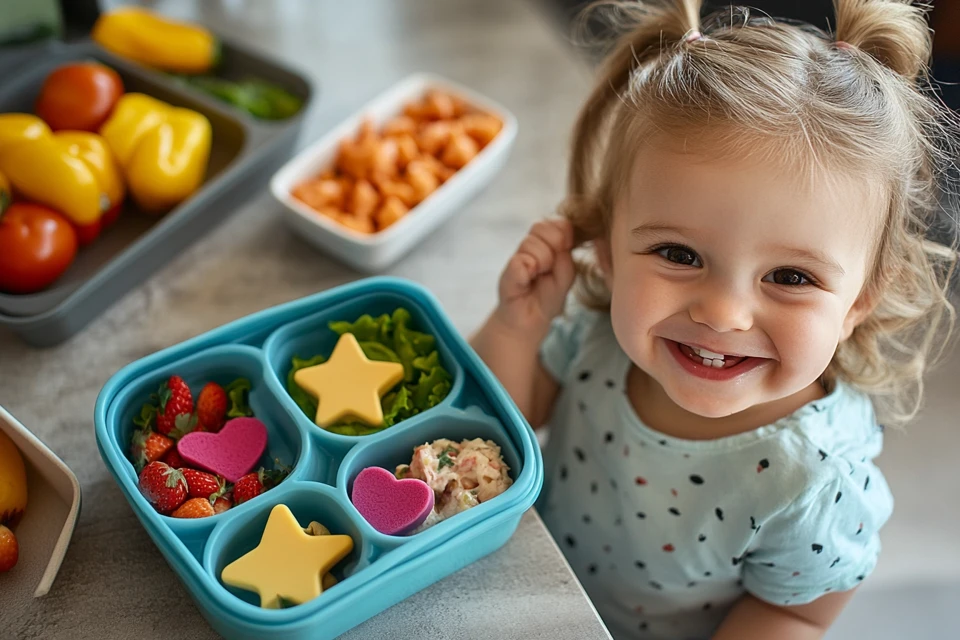Ever wonder, “What time should my toddler eat lunch?” You’re not alone! As parents, we all want to ensure our little ones are eating at the right times to fuel their growth and keep those tantrums at bay. But finding the perfect lunchtime for toddlers isn’t always easy—some kids get hungry early, while others seem too busy playing to sit down and eat.
The truth is, a well-timed lunch does more than just satisfy hunger—it plays a huge role in your toddler’s energy levels, mood, and overall development. So, let’s dive deep into what makes an ideal lunchtime for toddlers, why it matters, and how you can make mealtimes enjoyable (and stress-free!).
Table of Contents
Why Is a Consistent Lunchtime Important for Toddlers?
Imagine if you had to eat lunch at a different time every day—one day at 11 AM, the next at 2 PM. Sounds frustrating, right? Well, toddlers feel the same way! Routine is crucial for their developing bodies and minds.
The Role of Routine in Toddler Nutrition
Kids thrive on consistency. When meals happen at the same time every day, their bodies learn to expect food at certain times. This helps regulate their metabolism and prevents them from getting overly hungry (which often leads to crankiness and meltdowns).
Tip: Keeping a consistent lunchtime prevents sudden hunger spikes and reduces the chances of picky eating.
How Lunchtime Affects a Toddler’s Growth and Development
During toddlerhood (ages 1–3), kids are growing at an incredible rate. Their little bodies need a steady supply of nutrients to support brain development, muscle growth, and overall health.
Skipping or delaying meals can result in:
- Low energy levels (which means more fussiness and less playtime)
- Poor concentration (especially if they’re starting preschool or daycare)
- Disrupted sleep (hunger can wake them up at night!)
Impact on Sleep and Mood: The Science Behind Meal Timing
Did you know that toddlers who eat at irregular times are more likely to have trouble sleeping? That’s because our bodies rely on natural rhythms (circadian rhythms) that regulate sleep, hunger, and mood.
When toddlers eat lunch at a predictable time, their internal clock stays in sync. This means better naps, fewer mood swings, and an overall happier child.
What Time Should Toddlers Eat Lunch?
So, when exactly should you serve lunch? While every child is different, most toddlers do best with lunch between 11:30 AM and 12:30 PM.
Recommended Lunchtime Based on Age (12 Months – 3 Years)
| Age Group | Best Lunchtime |
|---|---|
| 12 – 18 months | 11:00 AM – 11:30 AM |
| 18 – 24 months | 11:30 AM – 12:00 PM |
| 2 – 3 years | 12:00 PM – 12:30 PM |
Tip: If your toddler still takes an afternoon nap, make sure lunch happens at least 30 minutes before naptime.
Factors That Affect the Ideal Lunchtime
Not all toddlers have the same hunger cues. Some factors that may affect the perfect lunchtime include:
- Wake-up time: Earlier risers may need an earlier lunch.
- Breakfast timing: If they eat breakfast late, they may not be hungry at 11:30 AM.
- Activity level: More active toddlers might need lunch sooner.
- Nap schedule: Some kids get extra cranky if they eat too close to nap time.

How Long Should a Toddler’s Lunch Last?
Toddlers are famous for being slow eaters! But how long should lunchtime last?
On average, a toddler’s lunch should take 15–30 minutes. This allows them enough time to eat without getting distracted or frustrated.
Tip: Avoid letting meals drag on for too long. If your child takes over 40 minutes to finish, they may be too distracted or not hungry enough.
Common Problems With Toddler Lunchtime & Solutions
Even with the perfect lunchtime schedule, problems can still pop up. Here are some common issues and how to fix them.
My Toddler Refuses to Eat at Lunchtime – What to Do?
Is your toddler turning up their nose at lunch? Here are some reasons why:
- They’re not actually hungry yet.
- The meal isn’t interesting enough.
- They’re distracted by toys or TV.
Solution: Try serving a smaller breakfast or adjusting snack times. Also, make sure lunchtime is screen-free and offer a variety of textures and colors on their plate.
My Toddler Gets Hungry Before Lunchtime – Should I Change the Time?
If your child seems starving before lunch, consider:
- Moving lunch 15–30 minutes earlier.
- Offering a healthy mid-morning snack.
Tip: Try giving snacks that contain protein and fiber to keep them fuller for longer.
My Toddler Is a Slow Eater – How to Handle It?
Some toddlers take forever to eat. If mealtime drags on for too long, they may be:
- Playing with food instead of eating.
- Getting full too quickly.
- Distracted by their surroundings.
Solution: Set a timer for 30 minutes, encourage self-feeding, and limit distractions (no toys or TV during meals).
What If My Toddler Skips Lunch?
Sometimes, toddlers just aren’t in the mood for lunch. If they skip a meal occasionally, don’t stress. Just make sure their next snack or meal is balanced and nutritious.
Tip: Avoid force-feeding! If they’re not hungry, respect their appetite and try again later.
Best Foods to Include in a Toddler’s Lunch
Now that we’ve established the ideal lunchtime, let’s talk about what should actually go on your toddler’s plate! A balanced meal should provide **protein, healthy fats, fiber, and essential vitamins** to keep your little one full and energized.

Nutrient-Rich Options for Growth and Energy
When planning a toddler’s lunch, focus on foods that fuel their active lifestyle. Here’s a simple breakdown of **what to include**:
| Food Group | Examples | Benefits |
|---|---|---|
| Protein | Chicken, eggs, beans, tofu, Greek yogurt | Builds muscle and keeps energy levels stable |
| Healthy Fats | Avocado, olive oil, peanut butter, cheese | Boosts brain development |
| Whole Grains | Whole wheat bread, brown rice, oats | Provides lasting energy |
| Fruits & Vegetables | Bananas, berries, carrots, cucumbers | Packed with vitamins and fiber |
| Dairy | Milk, cheese, yogurt | Supports bone growth |
Tip: Serve a variety of colors—kids are more likely to eat food that looks fun and inviting!
Easy and Healthy Toddler-Friendly Lunch Ideas
Need some meal inspiration? Here are a few **quick, nutritious, and kid-approved lunch ideas**:
- Mini Quesadilla: Whole wheat tortilla with cheese and beans, served with sliced cucumbers.
- Egg & Avocado Toast: Mashed avocado on whole-grain toast with scrambled eggs.
- DIY Snack Plate: Turkey slices, cheese cubes, whole-grain crackers, and grapes.
- Peanut Butter & Banana Roll-Ups: Whole wheat tortilla with peanut butter and banana slices.
- Veggie Mac & Cheese: Macaroni with hidden pureed carrots and broccoli.
Foods to Avoid During Lunchtime
Some foods might be difficult for toddlers to chew or could be potential choking hazards. **Avoid these foods or modify them to be toddler-safe:**
- Whole grapes: Cut them into quarters.
- Popcorn: Can be a choking hazard.
- Hard candies or gum: Difficult to chew and swallow.
- Hot dogs: Slice into thin strips instead of round chunks.
- Raw carrots or nuts: Chop finely or cook until soft.
Tip: Always supervise your toddler while they eat to prevent choking.
For 15 fun toddler meal ideas, check out Toddler Lunch Ideas: 15 Nutritious and Fun Meals.
How to Make Lunchtime Fun and Stress-Free
Let’s be honest—toddlers aren’t always the easiest eaters. They get distracted, throw food, or flat-out refuse to eat. So, how do you make lunchtime something they actually look forward to?
Creative Meal Presentation Tips for Picky Eaters
Sometimes, it’s not about what you serve—it’s about how you serve it! Try these **fun presentation ideas** to make meals more exciting:
- Use fun shapes: Cut sandwiches or fruits into stars, hearts, or animals.
- Serve a rainbow plate: Use a mix of colorful fruits and veggies.
- Let them dip: Kids love dipping! Offer hummus, yogurt, or peanut butter for extra fun.
- Make a smiley face: Use veggies or cheese to create a face on their plate.
Tip: Give food fun names! Instead of “broccoli,” call them “baby trees” to spark interest.
Engaging Toddlers in the Lunchtime Process
Toddlers love to feel independent. One way to make mealtime easier is by **getting them involved** in the process. Let them:
- Help pick out fruits and veggies at the store.
- Stir ingredients or sprinkle cheese on meals.
- Choose between two meal options to give them a sense of control.
Tip: Kids are more likely to eat food they helped prepare!
How to Encourage Independent Eating
As your toddler grows, they’ll want to feed themselves—but that can get messy! Here’s how to make it easier:
- Use toddler-friendly utensils that fit their small hands.
- Offer finger foods they can pick up easily.
- Expect a mess and use spill-proof bowls and mats.

Toddler Lunchtime and Daycare: What Parents Should Know
If your toddler attends daycare, their lunchtime may follow a set schedule. It’s important to **coordinate with caregivers** to ensure they’re eating well.
Adapting Lunch Schedule to Daycare Routines
Daycare meal times may differ from your home schedule. If needed, gradually shift your toddler’s routine at home so they adjust more easily.
Tip: Ask daycare staff what time lunch is served and try to match it on weekends.
Packing Nutritious Lunches for Daycare
Many daycares require packed lunches, and choosing the right foods can be tricky. Here’s a **sample lunchbox idea**:
| Food Category | Example |
|---|---|
| Main Meal | Whole wheat pasta with diced chicken and veggies |
| Side | Sliced strawberries and yogurt |
| Snack | Cheese cubes and whole-grain crackers |
| Drink | Water or diluted juice |
Pack nutritious meals – Try options from What to Cook for Lunch for a Toddler.
Communicating with Caregivers About Meal Preferences
Some toddlers eat well at home but struggle in daycare. If this happens, ask their caregivers:
- Are they eating enough?
- Do they struggle with certain textures?
- Are they distracted or rushed?
Understanding what’s happening during daycare meals can help you adjust their home routine if needed.
How to Adjust Lunchtime as Your Toddler Grows
As your toddler gets older, their appetite and mealtime behavior will change. It’s important to **adapt their lunchtime routine** based on their evolving needs.
Transitioning from Baby Feeding Schedules to Toddler Meal Plans
When transitioning from a **baby feeding schedule** to a toddler meal plan, keep these changes in mind:
- From multiple small meals to structured meals: Babies eat on demand, but toddlers benefit from set mealtimes.
- Introducing more solid foods: Move from purees to bite-sized finger foods and small portions of family meals.
- Encouraging self-feeding: Let them practice with a spoon and fork to build independence.
Tip: Start offering meals at the table with the family to encourage good eating habits.
Adjusting Lunch for Growing Appetite and Changing Preferences
As toddlers grow, their hunger levels and food preferences may shift. Some changes you might notice include:
- **Bigger appetites:** Growth spurts can cause sudden increases in hunger.
- **Changing taste preferences:** Foods they once loved might suddenly be “yucky.”
- **More independence:** They may start wanting to choose their own meals.
How to adjust:
- Offer larger portions during growth spurts.
- Introduce new flavors and textures regularly.
- Give them small choices (e.g., “Do you want cheese or yogurt with lunch?”).
Tip: Don’t panic if your toddler suddenly refuses their favorite food—preferences change often!
Final Tips for Creating the Best Lunchtime Routine for Toddlers
Here are some **final tips** to help make lunchtime smooth, stress-free, and nutritious.
Consistency is Key: Sticking to a Schedule
Maintaining a regular lunchtime helps toddlers develop **healthy eating habits** and prevents unnecessary hunger-related tantrums.
How to stay consistent:
- Set a fixed lunchtime and stick to it daily.
- Keep meal portions similar each day.
- Avoid snacking too close to lunch.
Making Sure Your Toddler Stays Hydrated
Proper hydration is just as important as a healthy lunch. **Toddlers should drink about 4-6 cups (32-48 oz) of fluids daily**, including water and milk.
Best drink choices:
- **Water:** The best way to keep them hydrated.
- **Milk:** Great for calcium and vitamin D.
- **Diluted juice (occasionally):** Stick to 100% juice and dilute with water.
Tip: Avoid sugary drinks like soda and fruit-flavored punches.
The Importance of Family Mealtime for Toddler Development
Eating together as a family teaches toddlers **social skills, healthy eating habits, and table manners**. Even if they don’t eat much, sitting together helps them associate mealtime with positive experiences.
Ways to encourage family meals:
- Eat at the table instead of in front of a screen.
- Let toddlers serve themselves (even if it’s messy!).
- Make conversation fun—ask simple questions like, “What was your favorite part of today?”
Conclusion: Finding the Perfect Lunchtime for Your Toddler
So, what is a good lunchtime for toddlers? **It depends on their age, schedule, and personal hunger cues**. However, most toddlers do best eating lunch between **11:30 AM and 12:30 PM** with a balance of protein, healthy fats, whole grains, and veggies.
Remember:
- **Stick to a routine** – Consistency helps with digestion, energy levels, and mood.
- **Offer a variety of foods** – Different flavors and textures prevent picky eating.
- **Make mealtime fun** – Use colorful foods, fun shapes, and creative names.
- **Listen to their hunger cues** – Don’t force them to eat if they’re not hungry.
- **Adjust as they grow** – Their needs will change over time!
By following these tips, you’ll create a **stress-free lunchtime routine** that keeps your toddler **happy, healthy, and full of energy**. Happy eating! 🍽️

